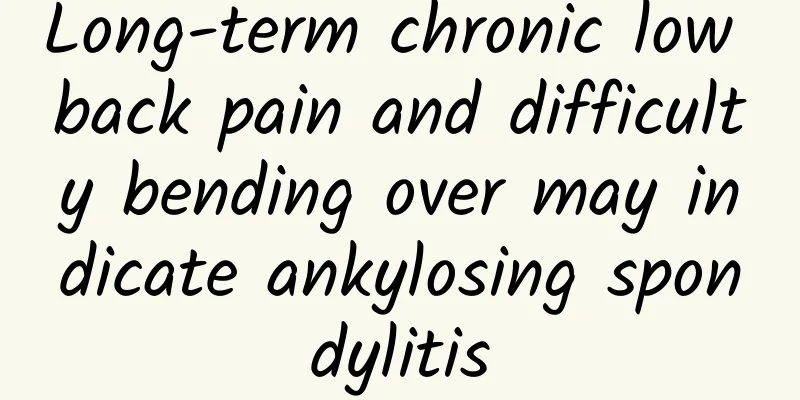Long-term chronic low back pain and difficulty bending over may indicate ankylosing spondylitis

|
Ankylosing spondylitis is a chronic inflammatory disease that primarily affects the spine and sacroiliac joints. If you find that your iliac lumbar region is stiff when you wake up in the morning, and if the lower back pain is relieved after activity but worsens after rest, you should be highly alert to ankylosing spondylitis. Ankylosing Spondylitis Self-Test Ankylosing spondylitis has an insidious onset, and the early symptoms are mild, so patients often ignore them. The following are some common symptoms. You can do a preliminary self-test: (1) Low back pain and stiffness for more than 3 months that cannot be relieved by rest. (2) Spinal pain, stiffness, and even limited mobility, with no obvious history of trauma or sprain. (3) Unilateral or bilateral sciatica with no obvious history of trauma or sprain. (4) Recurrent iritis. (5) Recurrent swelling and pain in the calcaneal tuberosity or heel pain. (6) Recurrent swelling and pain in the knee or ankle joints, joint effusion, and no obvious history of trauma or infection. (7) No respiratory symptoms such as cough, chest pain or tightness with no history of trauma, and limited chest movement. If you have two or more of the above symptoms, you should be alert to the invasion of ankylosing spondylosis. The dangers of ankylosing spondylitis Hazard 1: Ankylosing spondylitis is a disease caused by intervertebral disc lesions, which leads to bone hyperplasia of the upper and lower vertebrae, compressing the nerve roots and spinal cord or affecting the blood supply to the vertebral arteries, causing spinal inflammation. Hazard 2: Patients with ankylosing spondylitis may experience pain in the waist or lumbosacral region, accompanied by stiffness, which is intermittent and recurrent, and is accompanied by low back pain, limited lumbar movement, and symptoms of lumbar muscle atrophy. Hazard 3: In addition to the pain caused by inflammation of the spinal joints, ankylosing spondylitis can also cause permanent stiffness and deformation of the spine due to calcification of connective tissue. If there is bone loss and abnormal stress concentration, it will cause multiple fractures of the spine. Hazard 4: A small number of patients may experience invasion of the eyes, heart, lungs and kidneys. Invasion of the eyes can cause uveitis and iritis, and in severe cases may lead to blindness. Cardiac involvement is mostly asymptomatic or mild with aortic valvular insufficiency and conduction block. A small number of patients have complications such as upper pulmonary fibrosis or abnormal renal function. |
>>: Why is pharyngitis more common in summer? These are the reasons
Recommend
What are the symptoms of cor pulmonale?
Cor pulmonale is a common disease, which is gener...
How much saffron should be soaked in water for one drink?
Drinking saffron tea is a very simple and conveni...
What are the symptoms of myocardial ischemia in pregnant women?
Pregnant women must take myocardial ischemia seri...
Symptoms of knee tendinitis
There are many types of knee tendinitis, but they...
What to do when wisdom teeth hurt
Many people have had wisdom teeth. If you have wi...
Why is my poop sticky?
When people eat grains, they naturally need to de...
How long does it hurt after tooth extraction?
Anesthesia is required during tooth extraction to...
What are the causes of nodular arteritis? How to prevent it?
Nodular arteritis is a disease that has a great i...
TCM Treatment of Fatty Liver
The causes of fatty liver are very complex. The m...
Breast pain
Breasts are very fragile for women and need our c...
Cystic ductal dilatation
There are many causes of mammary duct cystic dila...
What medicine is the fastest way to open up the three burners?
Sanjiao is not a part of the body, but a special ...
Chest tightness
When we exercise too much, we will feel chest tig...
Spleen and stomach deficiency heat, this conditioning can effectively relieve
Lotus seed porridge"text-indent: 2em; text-al...
Abnormal menstruation at the age of 46
If you have irregular menstruation at the age of ...









